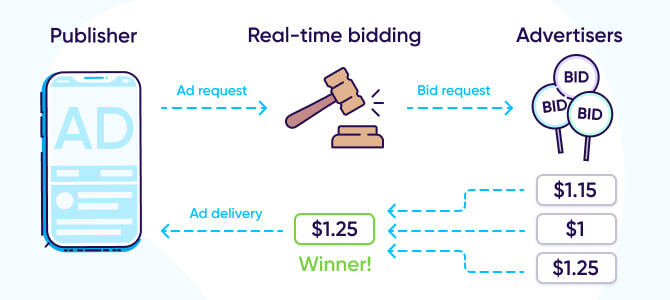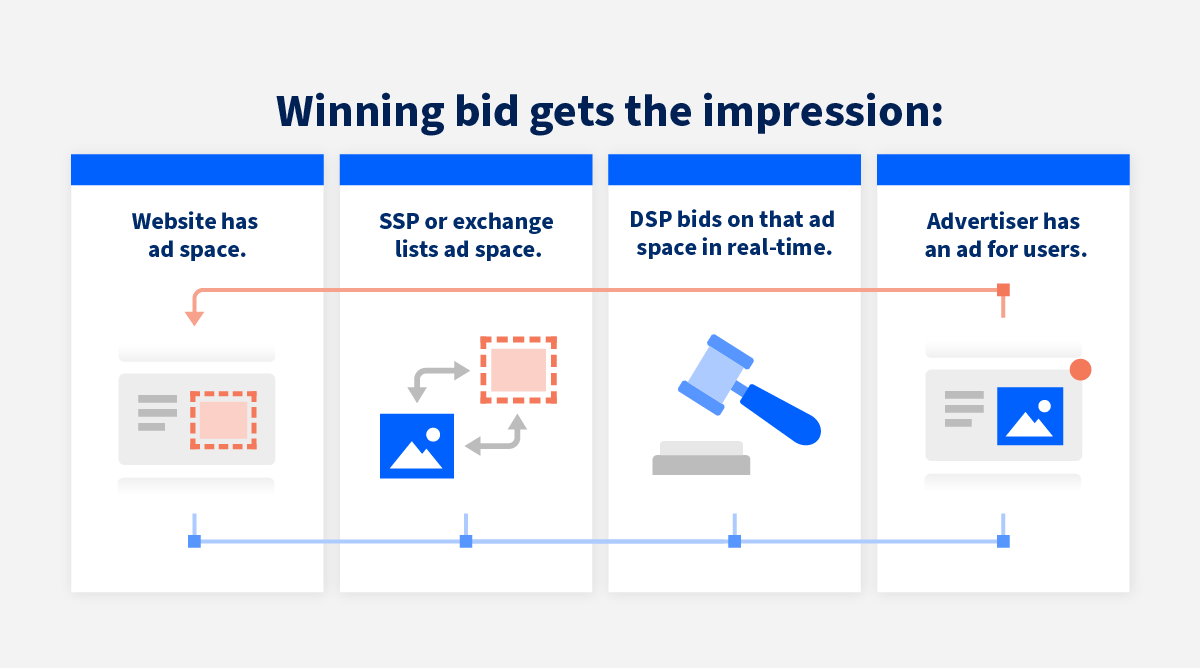In the dynamic world of digital advertising, Real-Time Bidding (RTB) has emerged as a powerful tool that is revolutionizing how ad space is bought and sold. By leveraging real-time auctions to purchase ad inventory, RTB offers unprecedented advantages for advertisers, publishers, and users alike. But what makes RTB such a game-changer in digital marketing? In this article, well delve into the key benefits of RTB, explore how it works, and explain why its a must-have in todays competitive digital landscape.

What is Real-Time Bidding (RTB)?
Real-Time Bidding (RTB) is an auction-based method of purchasing digital ad inventory, where advertisers bid for ad impressions in real-time as a user visits a website or app. Through RTB, the highest bidder wins the opportunity to show their ad to the user almost instantaneously.
RTB is part of programmatic advertising, an automated process that uses algorithms and data to purchase and place ads. Unlike traditional advertising models that involve direct negotiations for ad space, RTB offers dynamic pricing and enables advertisers to target their audience more precisely.
How Does RTB Work?
To understand the benefits of Real-Time Bidding, it’s essential to know how it operates:
- User Visits a Website: When a user navigates to a website or app, an ad request is sent to an Ad Exchange.
- Data Sent to DSPs: The Ad Exchange forwards this request, along with user data (like browsing behavior and location), to Demand-Side Platforms (DSPs).
- Advertisers Bid: Advertisers, using DSPs, evaluate the data and place bids based on the perceived value of reaching that particular user.
- Auction and Ad Selection: An auction occurs, with the highest bidder winning the ad impression. The winning ad is then displayed to the user.
- Ad Displayed: The ad is shown to the user in milliseconds.
This entire process takes place in real-time, hence the name Real-Time Bidding.
Key Benefits of Real-Time Bidding
Now that we understand what RTB is, lets explore the top benefits it offers to advertisers, publishers, and even consumers.
1. Highly Targeted Advertising
One of the standout benefits of Real-Time Bidding is its ability to target specific audiences with great precision. Advertisers can bid for impressions based on a variety of factors such as:
- Demographics: Age, gender, and income levels
- Behavioral Data: User interests, past browsing behavior, and purchasing history
- Location: Geographical location of the user
- Device: Whether the user is on a desktop, mobile, or tablet
With this level of granular targeting, advertisers can ensure their ads reach only the most relevant users. This improves the efficiency of campaigns and increases the likelihood of higher conversion rates.
“With RTB, advertisers can refine their targeting to an extent that was previously impossible with traditional advertising methods.” Source: Fraudlogix
2. Cost Efficiency and Budget Control
RTB offers a cost-effective way for advertisers to purchase digital ad space. Unlike traditional methods, where ad space is bought in bulk, RTB operates on a cost-per-impression (CPM) model, meaning advertisers only pay for the impressions that are most valuable to them.
Because of the auction format, advertisers only bid what they are willing to pay for an impression, which helps control ad spend. Furthermore, real-time optimization ensures that ad budgets are allocated efficiently, with the option to adjust bids and targeting in response to real-time performance data.
“With RTB, advertisers can ensure that they are paying for the exact impressions that matter to them, making the process far more budget-friendly.”

3. Real-Time Data and Optimization
Real-time data is one of the most powerful aspects of RTB. Advertisers can track the performance of their campaigns in real time, allowing them to make immediate adjustments to optimize results. For example, if a particular ad creative is underperforming, it can be replaced instantly without waiting for the end of a campaign cycle.
Additionally, A/B testing can be carried out easily to evaluate the performance of different ad creatives, targeting strategies, and bidding tactics. The ability to adjust campaigns on the fly ensures that advertisers can maximize ROI (Return on Investment) and improve the overall effectiveness of their campaigns.
4. Increased Transparency
Another significant benefit of RTB is the transparency it provides. In the past, advertisers often had limited visibility into where their ads were being shown, how much they were paying, and the overall effectiveness of their campaigns.
With RTB, both advertisers and publishers can gain clear insights into the performance of ads. Advertisers can see which websites, apps, or placements are driving the most engagement, while publishers can see how much they are earning for each impression. This visibility helps build trust and fosters more informed decision-making.
“Real-time bidding enables advertisers to track every impression, ensuring complete transparency in the ad buying process.”
5. Scalability and Flexibility
Real-Time Bidding is scalable and flexible, making it an excellent choice for advertisers looking to run campaigns of varying sizes. Whether you want to launch a hyper-targeted campaign for a niche audience or reach millions of users across different platforms, RTB provides the flexibility to scale your campaign accordingly.
RTB is also highly adaptive, allowing advertisers to bid for inventory across a wide range of websites, apps, and digital platforms. This flexibility ensures that ads are placed in the right context, delivering the right message to the right audience.
6. Reduced Ad Waste
Because advertisers only bid for impressions that meet their specific targeting criteria, the chances of ad waste (impressions shown to irrelevant users) are significantly reduced. This is particularly important in a world where digital advertising budgets are constantly under scrutiny.
By eliminating wasted impressions, RTB helps to increase the effectiveness of advertising spend. Advertisers can ensure that every dollar is spent reaching a highly relevant audience, increasing the likelihood of successful outcomes and higher conversion rates.
7. Better User Experience
Although RTB is highly automated and data-driven, it can also improve the user experience. By displaying ads that are relevant to the individuals interests and behavior, RTB ensures that users are not bombarded with irrelevant ads.
This personalized experience leads to higher engagement rates, as users are more likely to interact with ads that resonate with them. In turn, this can also lead to more positive perceptions of the brand and a better overall user experience on the website or app.
RTB vs. Programmatic Advertising: Whats the Difference?
While RTB is a form of programmatic advertising, the two are not the same. Programmatic advertising refers to the automated buying and selling of digital ad space, but it can also include direct deals, private auctions, and Programmatic Direct transactions, which do not rely on real-time auctions.
RTB, on the other hand, specifically refers to auction-based buying in real time. Its a subset of programmatic advertising, but its characterized by the ability to make split-second bidding decisions based on available data.
For more insights into the broader world of programmatic advertising, check out this guide on Programmatic Advertising.

Common Challenges of RTB
While RTB offers numerous advantages, its important to be aware of some of the challenges associated with it:
- Ad Fraud: Click fraud and other fraudulent activities can impact the effectiveness of RTB campaigns. Advertisers should work with trusted platforms and employ fraud prevention tools.
- Data Privacy Regulations: With increasing concerns about data privacy, advertisers must comply with regulations like GDPR and CCPA to avoid legal penalties.
- Complexity for Beginners: The RTB ecosystem can be complex, especially for new advertisers. It requires a good understanding of DSPs, SSPs, and ad exchanges to optimize campaigns effectively.
Frequently Asked Questions (FAQs) about RTB
Q1: How does RTB improve targeting?
RTB allows advertisers to target audiences with high precision by using data like demographics, behavior, and location. This leads to more effective and personalized ads.
Q2: Is RTB cost-effective for small businesses?
Yes, RTB is highly cost-effective because advertisers only pay for the impressions that are relevant to them, allowing small businesses to allocate their ad budgets more efficiently.
Q3: Can RTB be used for mobile ads?
Absolutely! RTB is widely used in mobile advertising, enabling advertisers to target users on smartphones and tablets in real time.
Q4: What is the difference between RTB and direct ad buying?
RTB involves real-time auctions where multiple advertisers bid for ad space, while direct ad buying typically involves negotiated rates and fixed pricing for ad placements.
Conclusion
The benefits of Real-Time Bidding (RTB) are undeniable. It offers advertisers a more efficient, targeted, and cost-effective way to buy ad inventory, while providing users with a more relevant and personalized ad experience. The ability to optimize campaigns in real time, reduce ad waste, and ensure greater transparency makes RTB an invaluable tool in todays digital advertising landscape.
If you havent already embraced RTB, now is the time to take advantage of its powerful capabilities. Whether youre a large enterprise or a small business, RTB can help you drive more effective advertising campaigns, improve ROI, and stay ahead of the competition.
For further reading and resources on RTB, check out Fraudlogix and Appsflyer.
